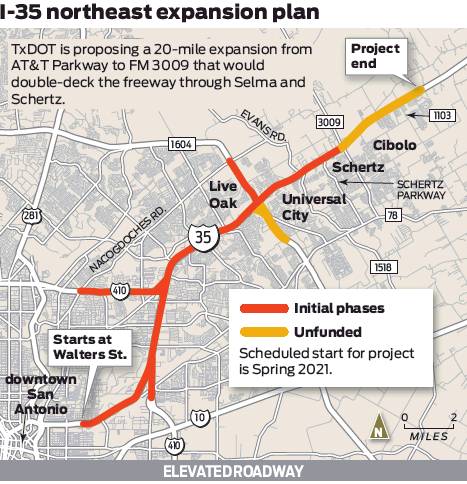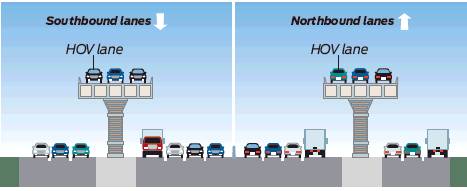Interstate 35 is en route to 5-year-long expansion
By Bruce Selcraig STAFF WRITER
The Texas Department of Transportation has unveiled plans for a 20-mile expansion of Interstate 35 that would make part of it a limited-access, nontolled and double-decked freeway northeast of Loop 410 through Selma and Schertz.
But don’t change your weekend plans. First-phase construction on the $2.1 billion project won’t begin until around spring 2021. Once construction starts, expect delays — it won’t finish until 2026.
The final phases have no timetable or dedicated funding yet, agency officials said.
“We think it will be a good project for us,” Schertz City Manager Mark Browne said. “Obviously, there will be a lengthy disruption, but that’s just a reality for a project of this magnitude. Our arterial roads will be getting a lot of additional traffic, but there’s really no alternative for I-35.”
The I-35 corridor between San Antonio and Austin is the busiest section of interstate in Texas, according to TxDOT — though it didn’t even make the list of “most congested” highways, measured by vehicle speed as well as volume, in the newest Urban Mobility Report by the Texas A&M Transportation Institute.
“Obviously, there will be a lengthy disruption.”
Schertz City Manager Mark Browne
It has an annual daily traffic count of some 169,000 vehicles, which the agency expects to explode to 393,000 by 2044 — assuming no mass transit projects decrease that congestion.
It’s the main artery for a 100-mile stretch of urbanity from Georgetown to San Antonio’s South Side that holds some 3.7 million people and is one of America’s largest growing metropolitan areas.
About $965 million of the project already is funded through state and federal sources, with a decision on another $602 million expected later this month from the Texas Transportation Commission. That would leave another $533 million to complete the work.
TxDOT has studied an expansion of this stretch of I-35 since the mid-1990s, according to the “Texas Highway Man,” an authoritative blog by Brian Purcell, a computer systems architect for a San Antonio university.
The early plans included toll lanes, but as political opposition to pay-as-you-go highways increased, their state funding decreased, and by 2015 planners had dropped the tolls and added elevated express lanes and HOV lanes along most of the route from AT&T Center Parkway to FM 1103.
The new lanes will be double-decked south of FM 3009 and then at surface level from there to FM 1103.
The plans were displayed publicly for the first time last week at a TxDOT open house that drew little objection from the roughly 100 people who attended.
Critics of such projects in Bexar County generally have called them a waste of billions of dollars to accommodate more automobiles by a state government that ignores mass transit and rail.
From AT&T Center Parkway to Rittiman Road, two traditional access roads, each with two lanes, will be built at ground level and will be the farthest outside lanes, just like normal. The ground-level main lanes will be three lanes in each direction, and above them will be two elevated sets of lanes.
From Rittiman to the Bexar County line, the elevated portion also will carry an HOV lane and the freeway main lanes will be four lanes wide. Though not identical, the regional highway most similar to this double-decked configuration would be I-35 as it passes through downtown Austin.
Why the double-decking?
“There’s no option but to go up. There’s really no more right of way,” TxDOT engineer Daniel Worden told a public hearing audience recently.
The idea behind elevated express lanes is to bypass ground traffic. Motorists will, however, be able to enter or exit the elevated lanes at five locations: at the Bexar County line, Loop 1604, Pat Booker Road, Loop 410 North and Loop 410 South.
Engineers estimate that when the first phase is complete, travel time on the current main lanes between the Bexar County line and Loop 410 North will be reduced by half from 20 minutes to less than
10. When the whole project is done, travel time between FM 1103 and AT&T Center Parkway may be cut from 45 to 20 minutes.



